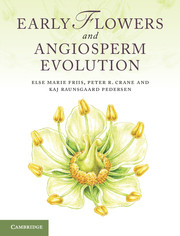Book contents
- Frontmatter
- Contents
- Preface
- 1 Introduction to angiosperms
- 2 The nature of the angiosperm fossil record
- 3 The environmental context of early angiosperm evolution
- 4 Stratigraphic framework and key areas for Cretaceous angiosperms
- 5 Angiosperms in context: extant and fossil seed plants
- 6 Origin and age of angiosperms
- 7 Phylogenetic framework and the assignment of fossils to extant groups
- 8 Fossils near the base of the angiosperm tree
- 9 Early fossil angiosperms of uncertain relationships
- 10 Early fossils of eumagnoliids
- 11 Fossils of monocots
- 12 Fossils of eudicots: early-diverging groups
- 13 Fossils of core eudicots: basal lineages
- 14 Fossils of core eudicots: rosids
- 15 Early fossils of eudicots: asterids
- 16 Patterns of structural diversification in angiosperm reproductive organs
- 17 History and evolution of pollination in angiosperms
- 18 History and evolution of dispersal in angiosperms
- 19 Vegetational context of early angiosperm diversification
- 20 The accumulation of angiosperm diversity
- References
- Index
20 - The accumulation of angiosperm diversity
Published online by Cambridge University Press: 07 September 2011
- Frontmatter
- Contents
- Preface
- 1 Introduction to angiosperms
- 2 The nature of the angiosperm fossil record
- 3 The environmental context of early angiosperm evolution
- 4 Stratigraphic framework and key areas for Cretaceous angiosperms
- 5 Angiosperms in context: extant and fossil seed plants
- 6 Origin and age of angiosperms
- 7 Phylogenetic framework and the assignment of fossils to extant groups
- 8 Fossils near the base of the angiosperm tree
- 9 Early fossil angiosperms of uncertain relationships
- 10 Early fossils of eumagnoliids
- 11 Fossils of monocots
- 12 Fossils of eudicots: early-diverging groups
- 13 Fossils of core eudicots: basal lineages
- 14 Fossils of core eudicots: rosids
- 15 Early fossils of eudicots: asterids
- 16 Patterns of structural diversification in angiosperm reproductive organs
- 17 History and evolution of pollination in angiosperms
- 18 History and evolution of dispersal in angiosperms
- 19 Vegetational context of early angiosperm diversification
- 20 The accumulation of angiosperm diversity
- References
- Index
Summary
The palaeontological information summarised in earlier chapters provides direct historical evidence of the pattern of angiosperm evolution through time. Such information is an important complement to contemporary approaches that use data from living plants to look back into evolutionary history. At the same time, living plants are the essential points of reference for any meaningful interpretation of the palaeontological record. Only from studies of the modern world can we understand the lives of plants and the roles they play in ecological systems. For these reasons the emphasis in this book has been on the integration of information from living and fossil plants, which we see as vital for a full understanding of plant evolution.
In this chapter we provide a brief integrated overview of the major patterns of angiosperm evolution as revealed by studies of living plants and the fossil record. We also provide more detailed consideration of selected groups of angiosperms with a particularly interesting or informative palaeontological history. Finally, we conclude with a brief consideration of angiosperm evolution through the Cenozoic to make the temporal connection between our primary focus on the Cretaceous fossil record, and the diversity of angiosperms that exists today.
- Type
- Chapter
- Information
- Early Flowers and Angiosperm Evolution , pp. 475 - 500Publisher: Cambridge University PressPrint publication year: 2011

